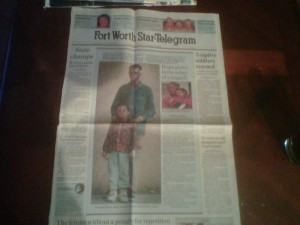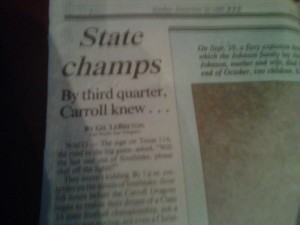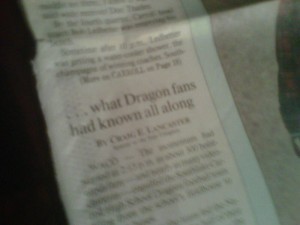A trip back in time, newspaper style
Earlier this week, my buddy and author/blogger David Abrams was kind enough to feature an essay by me on his blog, The Quivering Pen. It was a part of his ongoing series My First Time, in which authors share breakthrough moments in their writing lives.
It's a testament to the popularity of this series that several months passed between my submission of the essay and its publication. Reading it again this week, I was struck by just how much has changed — and how much hasn't — between my first front-page newspaper story at age 18 and my current career as a newspaper copy editor now, twenty-three years later.
Let's start with the physical newspaper itself. Here's a look at the front page of the Fort Worth (Texas) Star-Telegram from December 18th, 1988, the day my story appeared (the reason I have a copy: I'm fortunate enough to have a mother who thinks everything I've ever written is golden, and who catalogs it accordingly):
The design looks a bit rudimentary, doesn't it? At that point, while desktop publishing certainly existed, papers the size of the Star-Telegram generally had not made the capital investment to put design terminals and full-page outputters into their buildings. In those days, a layout editor would draw his/her design on a piece of paper called a dummy sheet, and the type would come out in long strips called galleys that would then be cut up by compositors and arranged somewhat like a puzzle. To get those color boxes in place, sheets of amberlith or rubylith would be cut and shot in the four-color process. Color photographs would be put in place through a similar process. Everything would be shot into negatives, and then the negatives would be used to create the aluminum plates that went onto the press.
The thing that really hits me now, looking at the page, is how wide it is. I measured it at 14 inches. By contrast, the paper I work for now, The Billings Gazette, has a page 11 inches wide (and less than 10 for the "image area," the space for the news and photos).
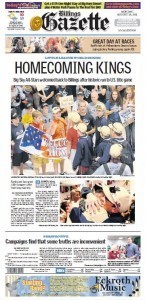 At right is an image of the Gazette Page A1 that I designed for Monday's edition. In addition to having a more modern look, it was leagues easier to put together. Everything happened at a single desk, on a single computer. Desktop publishing software is sophisticated enough to allow for applying stylized effects to photos (as I did with the promotional strip at the top, blending the photo with a background screen), to change the widths and numbers of columns of type with a single keystroke, to send the page, once finished, directly from my desk to the four plates — cyan, magenta, yellow, black — that impressed this image onto thousands and thousands of pages. None of this, of course, comes as any great surprise to anyone these days, but I think it's an interesting contrast with how I learned the trade two-plus decades ago. Back then, if a layout editor wanted to change, say, the width of the type from the the cover to the jump page, he/she would have to apply laborious typesetting code to the story on the editing end, then go to the typesetter and hope that the break came where he/she needed it to. If it didn't? Back to the editing terminal to adjust the coding. Now, type flows from one box shape to another with the greatest of ease.
At right is an image of the Gazette Page A1 that I designed for Monday's edition. In addition to having a more modern look, it was leagues easier to put together. Everything happened at a single desk, on a single computer. Desktop publishing software is sophisticated enough to allow for applying stylized effects to photos (as I did with the promotional strip at the top, blending the photo with a background screen), to change the widths and numbers of columns of type with a single keystroke, to send the page, once finished, directly from my desk to the four plates — cyan, magenta, yellow, black — that impressed this image onto thousands and thousands of pages. None of this, of course, comes as any great surprise to anyone these days, but I think it's an interesting contrast with how I learned the trade two-plus decades ago. Back then, if a layout editor wanted to change, say, the width of the type from the the cover to the jump page, he/she would have to apply laborious typesetting code to the story on the editing end, then go to the typesetter and hope that the break came where he/she needed it to. If it didn't? Back to the editing terminal to adjust the coding. Now, type flows from one box shape to another with the greatest of ease.
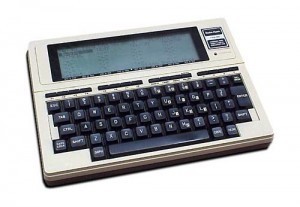 On December 17th, 1988, however, I wasn't in the office building a page. I was in a football stadium in Waco, Texas, trying to conjure a color story about the fans of the Southlake Carroll High School team. To write my story, I had a Radio Shack TRS-80 (affectionately called a Trash-80), which you can see at left. See that screen? When you were writing a story, you could see only a few lines at a time, and if you had to backtrack to check something you already wrote, well, let's just say that it wasn't so easy as CTRL-F. It was, instead, a lot of backtracking and squinting at dot-matrix characters on a gray screen in search of a certain passage or fact.
On December 17th, 1988, however, I wasn't in the office building a page. I was in a football stadium in Waco, Texas, trying to conjure a color story about the fans of the Southlake Carroll High School team. To write my story, I had a Radio Shack TRS-80 (affectionately called a Trash-80), which you can see at left. See that screen? When you were writing a story, you could see only a few lines at a time, and if you had to backtrack to check something you already wrote, well, let's just say that it wasn't so easy as CTRL-F. It was, instead, a lot of backtracking and squinting at dot-matrix characters on a gray screen in search of a certain passage or fact.
What the Trash-80 lacked in utility, however, it made up for in durability — I can't tell you how many times I dropped it on hard surfaces like sidewalks and colleagues' craniums, and it survived all of them — and tactile pleasantness. The keyboard, while a bit small, was incredibly easy to use for a touch typist like me. I came to love the Trash-80 and wish now that I had salvaged a few of them when they left newsrooms 15 years ago or so.
When it was time to transmit, I needed a direct connection to a landline, which wasn't always easy to find in high school gymnasiums. I whiled away many hours in school offices — a fax machine line was perfect for transmission — and teachers' lounges, listening to that pleasing whirr and ping of the TRS-80 as it sent my stories to where they needed to go. Now, of course, reporters in the field file in all kinds of ways — modem to modem, wireless, tweets, mobile phones and, in a pinch, by dictating a story to a fast-typing colleague back in the office.
In my essay, I wrote about a despondent few hours when the paper came out on December 18th, when I figured the story I'd written wasn't good enough because I couldn't find it anywhere.
As I said in the piece:
It was below the fold of the paper, a little three-inch sliver of type in the bottom left-hand corner of the page, but there it was. I'd missed it on the first pass because it was a companion piece to [Gil] LeBreton's, with a tiny elliptical headline. In my frantic search through the paper, I'd simply mistaken it for part of LeBreton's story.
LeBreton — or, as we know him, "Leb" — was (and is) one of the paper's star columnists, and accordingly, his story had been given top billing. You can see it here:
The headline, if you can't see it, reads "State champs | By third quarter, Carroll knew …"
And several inches below, you can see my moment of glory:
The continuation of the headline: "… what Dragon fans had known all along." (There's also, sadly, the precious byline of "Craig E. Lancaster." What can I say? I was 18 and thought that a middle initial would make me more writerly.)
It was a huge thrill to see this story in my hometown newspaper, and it remains one of the biggest moments of my career. At that young age, I thought I was on my way, that if I could make the front page as a teenager, I'd no doubt be winning Pulitzers by the handful in the years to come. Things didn't quite work out that way; within a few years, I'd made the hard left turn from aspiring reporter to full-time editor, someone toiling behind the scenes and someone whose name rarely shows up in the newspaper. It was the right choice for me, a job that better suits my sensibilities. And now, of course, my writing ambitions play out in a different way.
It's not what I would have imagined for myself twenty-three years ago, but I wouldn't change a thing.

